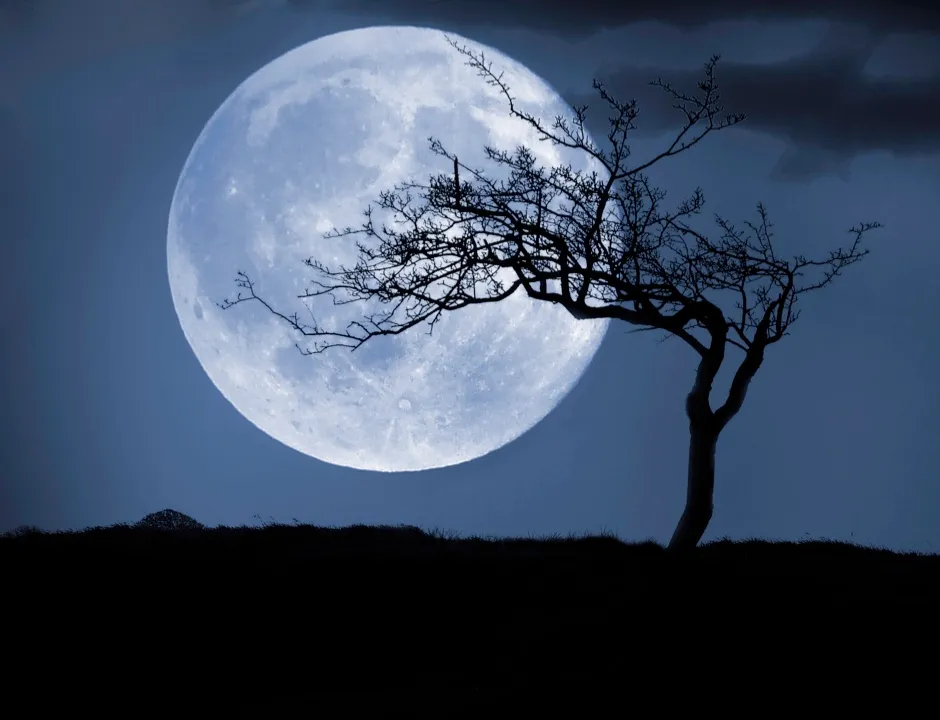On 31 October, Halloween night, it’s not just ghouls and ghosts we need to be watching out for. Look up to the skies for something else unusual: a blue Moon.
Despite its name, a blue Moon is not, in fact, blue. The modern term refers to a season with four rather than three full Moons, or an extra full Moon within a calendar month. The interval between two full Moons is about 29.5 days – as most months are 30 or 31 days long, it’s just possible for another full Moon to occasionally squeeze in.

Blue Moons are quite rare, taking place about every two and half years. On 1 October the first full Moon of the month occurred, the so-called Harvest Moon, which is traditionally the one that falls closest to the autumn equinox. The month's second full Moon, on 31 October, is known as the Hunter's Moon.
What makes this month's blue Moon even more unusual is that it’s the first time a full Moon has fallen on Halloween since 2001, and it won't happen again until 2039. This is thanks to something called the ‘Metonic cycle’, where a phase of the Moon will repeat on the same date every 19 years. This was calculated by the Ancient Greek astronomer Meton of Athens, in the 5th Century BC.
So where does the term ‘a blue Moon’ come from? According to Jodrell Bank, the oldest written record of ‘a blue Moon’ to mean something that rarely occurs, dates back to 1821. In his work Life In London, the journalist Pierce Egan wrote about the diverse characters, culture and language in London’s streets and recorded the use of the expression, providing a handy footnote to describe what it meant. There were a few more uses of the term by other authors in later works, so it is thought that it originated in London in the 19th Century.
Read more about the Moon:
- The next giant leaps: The UK missions getting us to the Moon
- What if we mined the Moon?
- Why is the Moon sometimes visible during the day?
As discussed, the Moon will be its usual non-spooky greyish-white colour. But can the Moon ever truly turn blue? Blue-hued Moons only tend to occur when there is a lot of smoke, ash or other particulates in the atmosphere. For example, following the enormous volcanic eruption of Krakatoa in 1883, huge amounts of ash and particles blasted into the air made the Moon appear blue for months afterwards. More recently, a giganticforest fire in western Canada raged from June to October in 1950. The smoke eventually travelled eastwards across the Atlantic and arrived over the UK and northern Europe in September, turning the Sun and Moon blue.
So while the Moon at Halloween might not be blue, it’s still a rare astronomical treat. It'll be visible around the entire world, and no special equipment is required to see it (although if you have a pair of binoculars, they'll allow you to take a closer look at some of its features). You should take some time to enjoy the sight – and it will do your teeth far less harm than the huge bag of pick ‘n’ mix you bought for ‘the trick-or-treaters’!
Reader Q&A: What would happen if there were no Moon?
Asked by: Derek Palmer, Eton Wick
The most immediate effect (other than the lack of moonlight, of course) would be on the Earth’s tides. With only the Sun’s gravitational influence, the difference between high and low tides would be reduced dramatically – as would tidal drag, which slows the Earth down at a rate adding about 0.002 seconds to the length of a day each century. Long term, the effects would be far more serious.
The climate of the Earth is sensitively dependent on the 23.5° tilt of the Earth’s axis, and without the stabilising presence of our relatively huge Moon, the gravity of the other planets would produce big changes in this angle – as it does with Mars, whose tilt changes by 60° over a few million years.
Read more:
